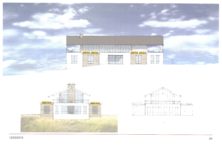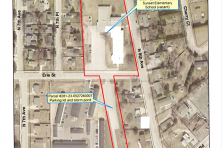Egg Harbor Road Site of Sixth City TID District
- Share
- Tweet
- Pin
- Share

Council decision making it official slated for April 19
Another Tax Increment District is expected to be formalized by the end of April within the City of Sturgeon Bay – this one along Egg Harbor Road.
Tax Increment District (TID) #6 runs an irregular path, taking into its area some new housing developments, vacant lots, the new Ace Hardware that’s under construction at the former Bank Mutual site and the new Rogue Theater building that’s under construction on 14th Avenue. The latter two developments were included because they broke ground at the first of the year, said Alder Helen Bacon, who chairs the Finance Committee where some of the details for TID #6 were first hashed out.
The official process began when the Sturgeon Bay Common Council unanimously hired financial consultant R.W. Baird on Feb. 1 for $6,750. The council is poised to consider the TID for approval during its April 19 meeting, and following that would be consideration for approval from the Joint Review Board on April 26. This board comprises individuals representing each of the taxing authorities: the Sturgeon Bay School District, County of Door, City of Sturgeon Bay and Northeast Wisconsin Technical College.
What the TID Will Pay For
TID #6 will pay for public improvements such as sewer, water and street upgrades. It will finance developer incentives in the form of cash grants or loans – $620,000 for developer incentives is earmarked in Baird’s analysis – to encourage and promote residential and commercial development.
The public improvements, specifically, are:
• A regional stormwater detention pond on the east side of North 12th Avenue to serve new and existing development.
• About 800 feet of new street to connect two existing dead-end streets on the east end of Alabama Place, extended westerly to the south end of North 12th Place, to improve east-west traffic flow and create street frontage for residential development.
• Public water and sanitary sewer in the Alabama Place extension.
• New street to connect Bonnie View Drive to North 8th Place.
• A pedestrian and bicycle path between Bonnie View Drive and Egg Harbor Road.
• Repaving Cherry Court and North 8th Place.
• Paving about 300 feet of existing gravel shoulder on the west side of 14th Avenue and adding street trees.
• Resurfacing Egg Harbor Road from North 8th Avenue to North 14th Avenue.
How the TID Will Pay for the Improvements and Incentives
The improvements and incentives are financed with debt and TIF (Tax Increment Financing) revenue. These expenditures are projected to cost $2,390,000, plus financing/interest costs (projected at $891,791) during the TID’s 15-year expenditure period, according to Baird’s analysis.
The TID is expected to raise $6,424,609 in additional tax revenue, which will primarily be used to pay the debt and incentives. Land and improvement values of approximately $16.4 million will be created by the end of 2028, according to Baird.
TID #1 Decision Pending April 19
Sturgeon Bay Mayor David Ward said during a past council meeting that they need to keep an eye on the percentage of the tax base that’s coming from the city’s TIDs.
“We don’t want too much of your tax base on TIF,” he said. “One time, almost 12% of tax valuation was in TIF, but when [TID] #1 closes down, it will be more in the neighborhood of 5-6%,” he said.
Since the mayor said that in February, the council has gone in a different direction with TID #1, wanting to turn it into an affordable-housing fund. By statute, the city is allowed to divert revenue from an existing TID into an affordable-housing fund for one year only. After that, the TID would expire.
The council is slated to decide whether to do this during its April 19 meeting. If approved, some of the diverted funds would be earmarked for a 64-unit apartment complex between Sawyer Drive (Oak Street) and Target, with rents of between $800 and $1,000 a month.
Maybe It Can’t Be Repeated Enough: What’s a TID/TIF?
And when is it lawful/appropriate to use one?
Tax Increment Financing (TIF) is a financing option that allows a municipality (town, village or city) to fund infrastructure and other improvements through property-tax revenue on newly developed property.
A municipality identifies an area, the Tax Incremental District (TID), as appropriate for a certain type of development, and it identifies projects to encourage and facilitate the desired development. Then as improvements are made and property values rise, the municipality uses the property tax paid on that development to pay for the projects.
After the project costs are paid, the municipality closes the TID, and the municipality, schools, county and technical college are then able to levy taxes on the value of the new development.
One key basis for the use of TIF is the “but for” requirement: A municipality must affirm that the development would not happen “but for” the use of TIF. That is, the municipality must believe that without TIF, the development would never happen. This requirement is important to ensure that TIF assists development projects that need help, but that it is not a gift of tax dollars to private developers or property owners.
— Wisconsin Department of Revenue

Tax Increment Financing (TIF) is a financing option that allows a municipality (town, village or city) to fund infrastructure and other improvements through property-tax revenue on newly developed property.
A municipality identifies an area, the Tax Incremental District (TID), as appropriate for a certain type of development, and it identifies projects to encourage and facilitate the desired development. Then as improvements are made and property values rise, the municipality uses the property tax paid on that development to pay for the projects.
After the project costs are paid, the municipality closes the TID, and the municipality, schools, county and technical college are then able to levy taxes on the value of the new development.
One key basis for the use of TIF is the “but for” requirement: A municipality must affirm that the development would not happen “but for” the use of TIF. That is, the municipality must believe that without TIF, the development would never happen. This requirement is important to ensure that TIF assists development projects that need help, but that it is not a gift of tax dollars to private developers or property owners.
— Wisconsin Department of Revenue



